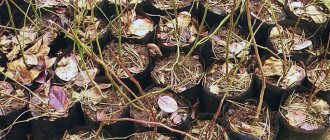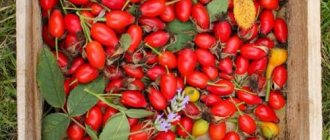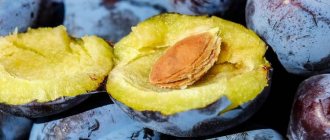Are grapes suitable for long-term storage at home?
Many people consider storing grapes to be a useless exercise. The culture is very fastidious and susceptible to fungal diseases, midge attacks, and rotting. Amateur gardeners are more accustomed to consuming berries in the form of raisins or jam.
Experienced winegrowers know that keeping grapes fresh is
not an easy task, but it can be done . It is important to choose the right variety and place of shelter, monitor climatic conditions, and promptly eliminate unfavorable factors. The fruits are fragile and contain a lot of juice, which is quickly lost under unsuitable conditions.
In boxes or wooden tubs
Wooden barrels are convenient for storing grapes. The bottom is covered with a layer of sawdust. They are also interspersed with stacked bunches of grapes.
It is important to distribute them evenly at some distance from each other. Cover loosely with a lid to create natural air exchange inside.
It is not recommended to use pine sawdust. They prefer linden and poplar. Ideally, use cork powder.
Another option for keeping the harvest fresh is low boxes. They make a straw flooring and lay out the vines with the ridges up.
Best varieties for storage
Late varieties are ideal for storage. They have elastic flesh and peel, stable immunity to pests, and a dense waxy coating on the fruits. Not all regions of Russia can grow them. Dark varieties are better stored than light varieties, which over time develop dark spots and brown spots that spoil the appearance of the product.
When choosing grapes for long-term storage, pay attention to the grapes:
- With loose clusters and large berries. They should be undamaged and hold tightly to the stalk.
- High in sugar. It helps the crop survive longer. The sweeter the variety, the better the keeping quality.
- With dense clusters. They do not break when suspended.
Varieties with a high calcium content are best stored. This includes Moldova. An excellent option would be the following varieties:
- Alexandria Muscat;
- Hamburg Muscat;
- Moldavian black;
- Lydia;
- In memory of Negrul.
The greatest shelf life (up to 139 days from the moment of collection) is shown by the following varieties:
- Moldova;
- In memory of Negrul;
- Anniversary of Moldova;
- Original;
- Crane Anniversary;
- Kutuzovsky.
The following are stored for up to 111 days:
- Liana;
- Light;
- Kriulyansky.
The key to a guaranteed harvest is to properly preserve the vine in winter
Grapes are a southern creation, but those who live a little further north are also not averse to growing this heat-loving plant on their own agricultural lands and getting a guaranteed harvest of beautiful, aromatic berries.
And for the vine to be healthy and bear fruit well, it needs appropriate care, one of the main qualities of which is preparing the vineyard for winter, because if you properly preserve the grapes for the winter, this is the key to a secure harvest in the autumn. In this article we will share with you how to preserve grapevines in winter.
Properly storing grapes for the winter is the key to a secure harvest in the fall
/p>
Selection and preparation of bunches
Taking grape harvesting seriously will help keep it tasty and fresh for a long time:
- Collect brushes on a sunny day. Do not cut fruits in foggy, rainy weather. Excess moisture will cause the product to quickly rot.
- Select fully ripe bunches. Do not use unripe or overripe ones for storage.
- Wear thin gloves and try not to touch the berries so as not to erase the protective wax layer. It will preserve their taste and aroma.
- Using rounded scissors, remove damaged berries from the bunch - they can become sources of rotting.
Choosing a grape variety and picking it correctly is only half the battle. The safety of the product is also affected by caring for the plant itself:
- Stop watering the plant 40 days before harvest. The berries will lose excess moisture and gain sugar.
- Unload the vine from some of the bunches in a timely manner.
- Excess nitrogen fertilizers will not allow the berries to last long. Limit such feedings, or better yet, replace them with potassium phosphate ones.
How to preserve grapes after harvest. Features and rules of harvesting
Harvesting grapes is a labor-intensive process that requires skills and technology, depending on the variety and further use of the product.
Table varieties
Table grapes are harvested in a state of full ripeness, which is assessed by taste and external characteristics described in the previous paragraph. In addition, pay attention to the sugar level: for ripe berries this indicator should not be lower than 12–14%; the higher the sugar content, the better the harvested product will be stored. It should be taken into account that the grapes ripen unevenly, and accordingly, harvesting in this case is carried out in several stages as the berries are ready.
The table variety product is harvested in dry weather, in the first half of the day, the clusters are cut by hand using garden shears, and then placed in wooden boxes with the stalks facing up. Place paper or grape leaves on the bottom of the container. Filled boxes should be immediately put into the shade. You cannot cut the fruits immediately after rain; it is better to postpone harvesting for a couple of days so that the moisture evaporates.
Important! When picking grapes by hand, you should try not to damage the wax coating on the berries, as it not only improves their appearance, but also protects them from rotting.
Technical varieties
Harvesting technical varieties of crops is slightly different: as a rule, in this case, harvesting is done not by hand, but by special machines resembling a combine harvester. This method significantly speeds up the work, but significantly spoils the presentation of the berries; accordingly, it is used only for a product that will be used for further processing, for example, for making wine or juice.
Technical grape varieties are harvested without waiting for all the bunches to ripen; usually in this case they are guided by the percentage of sugar in the juice of the berries (as soon as it reaches the maximum level for a given variety, harvesting can be done).
Storage locations
The capricious culture is placed in a dark, dry and clean place. When choosing a room, be sure to take into account the following factors:
- Humidity. In shelter it should be no more than 80%. Lime or sawdust placed in small containers next to the fruit will help reduce its level. This will prevent the fungus from spreading.
- Light. From its influence, acids are destroyed, and this leads to rotting. The best storage option is a darkened room.
- Temperature. Temperatures that are too low or too high will spoil the fruit. The best option is from 0 to +5°C.
- Air. The room is regularly ventilated, especially if mold appears.
Grapes should not be washed after harvesting. It is advisable to place the clusters at a short distance from each other.
Suitable for storing the product:
- Cellar. Be sure to treat the room with antibacterial agents or whitewash it.
- Fridge. Preserves the product for a long time if the bunches are undamaged. Store in the fruit drawer or freezer.
- Balcony. Not the best option, but if you put the grapes in cardboard boxes or boxes and ensure optimal temperature and humidity, the fruits will last for several months.
When storing grapes in the cellar, there should be no other fruits or vegetables there.
How to store grape cuttings in the cellar or basement during the winter
An ideal place for wintering would be a cellar or basement. The basement of a residential high-rise building is not accessible - hot communication pipes pass there, therefore, the temperature in the room exceeds the norm.
At elevated temperatures, the forelocks awaken, begin to actively consume microelements, secrete carbohydrates, and the kidneys can begin to develop.
After disinfection and drying, the prepared stock is placed in cellophane with its lower part, and then covered with sawdust or sand to preserve water. Once a month, the workpieces need to be checked for the presence of water - dried branches must be moistened, and if mold is found, the workpieces must be wiped with a cloth soaked in a 3% solution of copper sulfate or a weak solution of manganese.
Thanks to the accumulation of carbon dioxide in the bags, the plant seems to preserve itself for the winter period, due to which it stands well until spring.
From time to time, winegrowers do not use desiccants, but tie the planting agent in a bag without sand. In this case, moisture checks are carried out more often. When storing grape cuttings in the winter, do not forget to attach the names of varieties to the branches so that there is no trouble during planting.
When wintering seedlings in the cellar, it is not necessary to adhere to the rules of the neighborhood - grapes get along well with vegetables, twists, and pickles. The only exception is chemicals.
VIDEO TO HELP:
Storage methods
Every year, gardeners experiment and offer new storage options. To treat yourself to juicy berries in the winter, use proven methods.
In water
With a small amount of harvest, water containers will come to the rescue:
- The bunch of grapes is cut together with a piece of vine measuring 15-20 cm.
- Its end is placed in a bottle filled with distilled water with 1 tablet of acetylsalicylic acid or activated carbon dissolved and secured at an angle.
- The bunches are hung so that they do not touch each other.
- The berries are systematically inspected and rotten and fallen ones are immediately removed, and the water is changed.
On green ridges
A simple design does not take much time, but with this method there is a high risk of drying out the berries:
- A strong steel rope is pulled between the walls.
- The bunches are tied together in pairs.
- Hang at a short distance from each other.
Regular ventilation and temperature control will help preserve fruits for up to 3 months.
Attention! It is important to monitor the appearance of midges in the room and prevent the berries from rotting. This will ruin the entire harvest.
In boxes
For grapes, choose boxes with low sides. Before placing the bunches there, the bottom is covered with 3-4 cm of linden or poplar sawdust. The brushes are laid out with their ridges up so that they do not touch each other.
The top of the bunches is covered with a small layer of sawdust. The boxes are placed in a dark, dry and cool place.
On shelves
Another option is to place your brushes on racks. The distance between them should be at least 20 cm, and the racks themselves should be no more than 90 cm deep. The shelves are covered with straw or straw ash, which has antiseptic properties and will protect the grapes from pests.
Reference. The grapes are laid out with ridges facing away from you. This makes it easier to inspect damage and remove rotten berries.
In barrels
This method allows you to save the harvest for up to 8 months. Cork powder is poured into the bottom of a small barrel.
The brushes are laid in several loose layers, each of which is sprinkled with cork powder. The barrel is covered with a lid and placed in a cool place.
On green ridges
Clusters are well preserved when cut together with branches at a distance of 2 internodes on both sides. The lower part of the branch is lowered into prepared bottles of water, and the upper part is cut off with pruning shears, leaving 1 bud. To prevent rot from forming in the bottle, add 3-4 tablets of activated carbon or acetylsalicylic acid to the water, after crushing them.
This method allows you to preserve the harvest for up to 2 months, but the sweetness of the berries and aroma decrease over time.
The disadvantage of this method is the high risk of drying out the berries.
Other ways to store grapes
If the above options are not suitable, consider other methods.
Freezing
A freezer will help keep berries fresh without unnecessary equipment. Both dark and light varieties are suitable for freezing.
To successfully freeze a product, follow these simple steps:
- The berries are separated from the stalk, washed and sorted.
- Dry on paper towels.
- Place the grapes in the refrigerator for 2-3 hours to cool.
- Then put it in the freezer for 30 minutes.
- The berries are taken out and packaged in bags or containers.
- Put it in the freezer.
The optimal temperature is -25°C. Before consumption, berries are immersed in cold water for an hour. Secondary freezing is prohibited. When frozen, the product retains all its beneficial properties.
Drying
It is also useful to eat berries in dried form . Raisins are rich in potassium, phosphorus, fiber and serve as an excellent source of energy. It's easy to make it at home.
A simple method that does not require financial costs is natural drying. To do this, the grapes are sorted, washed and blanched for 3-4 minutes in a soda solution at the rate of 1 tbsp. l. for 1 liter of water. After processing, the wax coating is erased and a mesh is formed through which moisture escapes faster. The berries are dried with a towel, placed on a sieve and placed in the sun. It takes 20-30 days to prepare raisins.
Important! During drying, the sieve is covered with gauze to prevent birds and insects, and brought indoors at night.
It’s faster to make raisins in an electric dryer or oven. It is necessary to blanch the berries in a soda solution before drying.
Conservation
You can enjoy the sweetness of grapes without freezing or drying. Canning will help with this. Sunny berries will decorate the table and delight the household. The main thing is to choose ripe ones.
You can preserve grapes in sugar syrup using a simple and reliable recipe.
For a container with a volume of 0.7 liters you will need:
- 500 g berries;
- 100 g sugar;
- 1 tsp. vanilla sugar.
Cooking method:
- The berries are washed, sorted and placed in containers. Do not fill jars up to the neck.
- Add both types of sugar.
- Pour boiling water over, leaving 1 cm of free space on top.
- Cover the container with a lid and sterilize for 20-30 minutes.
- Roll up the lids and leave upside down until completely cool.
Jams, juices, jellies, jams are also prepared from grapes, and preserved in a marinade with spices.
Features of shelf storage
Shelves for storing grapes should be no more than 50 cm wide and the distance between the rows should be at least 1 m. The method is based on unhindered air circulation between the berries.
The shelves are covered with a backing made of straw, sawdust, and peat. In this case, the substrate must be treated with potassium permanganate. The grapes are laid with ridges in one direction and in one row in thickness and width. If you lay it in 2 rows wide, the shelf life will be reduced by 2 times.
This method is designed for storage for no more than 3 months.
Shelf life
How long do grapes last? At room temperature it will last only 72 hours, in water and boxes - 2 months, in a suspended state - 3 months, in the refrigerator - up to 6 months, in the freezer - from 8 to 12 months.
Additional processing of fruits will help increase shelf life.
How are grapes processed for long-term storage?
A small amount of berries will be preserved by treating them with paraffin or wax melted to 70°C. But before eating, the grapes will have to be immersed in water heated to the same temperature.
When storing in boxes, potassium metabisulfite tablets are placed at the bottom. When they react with oxygen, sulfur dioxide is released. It has excellent antifungal and antiviral properties.
Sometimes brushes are processed:
- fungicides “Acrobat”, “Polychom”, “Paracelsus”, “Fundazol”, “Topaz”, “Quadris”, etc.;
- potassium permanganate solution;
- calcium chloride solution.
Best friend is the refrigerator
Gardeners recommend storing grapes in small volumes in the home refrigerator. However, if your household device allows, you can increase the amount from a couple or three to 10-12 kilograms. After all, storing grapes in the refrigerator is one of the best ways to extend their life all winter and longer, up to 6-8 months.
Humidity should vary between 85-95%, and temperature - from zero to plus two. Previously frozen and thawed crops are prohibited from being placed in the cold again. Inside, the grapes turn into mush, change shape and lose their beneficial properties.
You can store either the bunches or the fruits individually in the freezer. The main thing is to wash them first, dry them and pack them in a plastic container or plastic bag.
Method using a freezer
The main rule for freezing grapes is deep and quick freezing. Then the ice will not have time to crystallize into large crystals and will not tear the tender pulp. The chamber temperature should not be higher than -24°.
The brushes are cooled to +5...+8°, then placed on a tray and placed in the freezer. 2-3 hours after complete freezing, take out the tray and place the berries in containers, jars, or any other container that will not interfere with the chamber, and put the product back. All operations are done quickly so that the product does not have time to thaw.
Basic rules for freezing berries
Freezing berries in the freezer is somewhat different from storing them in the refrigerator.
Among the features of this method are the shelf life (up to a year), the product’s barely noticeable loss of shape, beneficial and taste properties, and versatility. Any variety can be frozen, but for longer storage it is better to take dark varieties. As for light varieties, they can be frozen for up to 8 months in sugar syrup, where the sugar percentage ranges from 30–35% at a temperature of –10°C.











